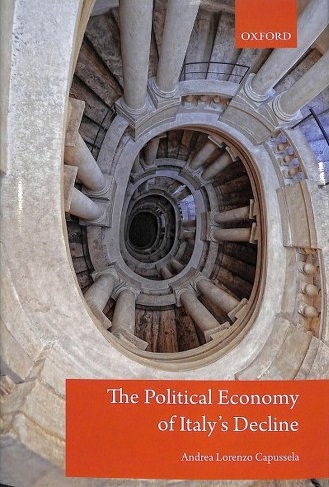
 The image of the spiral is central in Andrea Lorenzo Capussela’s The Political Economy of Italy’s Decline. The word appears in three of the book’s nine chapters (four, eight, and nine), and an illustration of a spiral appears on the book’s cover. It is a downward spiral, the sign of Italy’s ongoing and perhaps irreversible economic decline. In his book, Capussela, who acted as head of the economics unit of the International Civilian Office in Kosovo from 2008-11, and then as European Union adviser to Moldova’s minister of economy and deputy prime minister, illustrates Italy’s decline through an analysis of the nation’s Total Factor Productivity (TFP)—a measure of technological and organizational progress. In the late 1950s and early 1960s, Italy’s TFP was relatively high as the nation played catch-up with its European neighbors. Now, though, and since 1980 especially, Italy’s TFP has dropped considerably, to about half that of the Eurozone average. Capussela’s explanation for the decline comes out of a fairly long review of extant scholarship on the subject, which accounts for the first sixty or so pages of the book. After this, the book seeks to explain Italy’s decline through a number of chapters outlining Italy’s economic history going from the time of Italian unification in the nineteenth century up to the present day; the book concludes with a possible way forward for the beleaguered nation. The structure of the book is odd and does not do it any favors in terms of readability. Capussela’s review of scholarship is thorough and extensive to a fault. There can be no doubt that he has done his homework. But it is rather tedious and overly long. An editorial choice that might have engaged the reader more would have been to weave the review of the extant scholarship into the body of the various phases of the historical analysis. In addition, cramming a jam-packed 180 years of Italian history into such a relatively small space runs the risk of falling between two stools: a narrative that, on the one hand, is too elliptical for readers new to Italy to be able to follow; and, on the other, a narrative that is too sketchy to say much that is new to readers familiar with the vicissitudes of the nation.
The image of the spiral is central in Andrea Lorenzo Capussela’s The Political Economy of Italy’s Decline. The word appears in three of the book’s nine chapters (four, eight, and nine), and an illustration of a spiral appears on the book’s cover. It is a downward spiral, the sign of Italy’s ongoing and perhaps irreversible economic decline. In his book, Capussela, who acted as head of the economics unit of the International Civilian Office in Kosovo from 2008-11, and then as European Union adviser to Moldova’s minister of economy and deputy prime minister, illustrates Italy’s decline through an analysis of the nation’s Total Factor Productivity (TFP)—a measure of technological and organizational progress. In the late 1950s and early 1960s, Italy’s TFP was relatively high as the nation played catch-up with its European neighbors. Now, though, and since 1980 especially, Italy’s TFP has dropped considerably, to about half that of the Eurozone average. Capussela’s explanation for the decline comes out of a fairly long review of extant scholarship on the subject, which accounts for the first sixty or so pages of the book. After this, the book seeks to explain Italy’s decline through a number of chapters outlining Italy’s economic history going from the time of Italian unification in the nineteenth century up to the present day; the book concludes with a possible way forward for the beleaguered nation. The structure of the book is odd and does not do it any favors in terms of readability. Capussela’s review of scholarship is thorough and extensive to a fault. There can be no doubt that he has done his homework. But it is rather tedious and overly long. An editorial choice that might have engaged the reader more would have been to weave the review of the extant scholarship into the body of the various phases of the historical analysis. In addition, cramming a jam-packed 180 years of Italian history into such a relatively small space runs the risk of falling between two stools: a narrative that, on the one hand, is too elliptical for readers new to Italy to be able to follow; and, on the other, a narrative that is too sketchy to say much that is new to readers familiar with the vicissitudes of the nation.
That said, what emerges from the review is Capussela’s contention that the major culprits in Italy’s economic decline have been the nation’s institutions. It is the institutions, in fact, that can be held responsible, not so much for not thwarting the rampant corruption, but for promoting it in such a way that it has become part of Italy’s social order. The dominant social order of a nation has a special importance for Capussela. By social order, he means the political-economic equilibrium within a society that shapes the wants and needs of individual citizens and ultimately directs their political choices and behavioral attitudes. When this equilibrium is stable, Capussela argues, the social order reproduces itself even in the face of reforms aimed to change the system.
Italy is stuck in a mid-phase between typologies of social order: that is, it is a nation characterized by a limited-access social order, where corruption and nepotism are rife, located on a rung below the advanced open-access social order that has been achieved by Italy’s competitors on the world market. By “open-access social order” Capussela means the kind of neoliberal economy that seems to be the goal sought for all nations, the merits—and demerits—of which Capussela does not question for a second. History, it would seem, really has come to an end, and borrowing from and adapting the liberal philosopher Benedetti Croce’s dictum that “We cannot but be Christians,” – in our contemporary world“we cannot but be neoliberals.”
What is worse for Italy is that a vicious cycle of corruption seems destined to lead the nation ever more downward and further away from achieving the status of open-access social order. The spiral is all the more insidious insofar as it is propelled by rational choices made by ordinary Italian citizens.
The downward cycle works like this:
Once a level of corruption is tolerated by the nation’s institutions—in the form of tax dodging, nepotism etc.—and citizens begin to realize that they will be unlikely to be able to access services and enjoy their rights unless they too engage in the same corrupt practices embedded in the social order. Indeed, given how the social order is organized, even for public minded citizens it becomes a rational choice to engage in corrupt practices, if only to ensure better schooling and health care for their families.
The persistence of this corrupt social order, argues Capussela, is so strong that it has prevented possible moments of rupture—the anti-corruption investigations and trials of the early 1990s—Mani pulite (Clean hands)—from having any real and lasting effect. If one generation of corrupt officials get caught with their hands in the till, another one soon follows and takes their place.
This, of course, is a rather dispiriting scenario. In a decidedly bleak boo, Capussela may have felt the need to conclude with some rays of hope in the form of his belief that innovative ideas injected into Italian society can be powerful enough to spur on reforms that will have lasting positive and transformative effects on the social order. What he means by this, I think, is the elaboration of an attractive and enticing political vision by politicians/intellectuals able to grab the imagination of the citizenry and push it into a demand for change—something akin to Obama’s “Yes, we can,” in the ever more distant 2008. Magari (I wish it were that way), as the Italians say. This is wishful thinking rather than rational thought. Where such a vision would come from in contemporary Italy is anyone’s guess. Looking at Italy’s political class at the beginning of 2019, the phrase that comes most readily to mind is less “Yes, we can,” than “No, they never will ….”
Reviewed by David Ward, Wellesley College
The Political Economy of Italy’s Decline
by Andrea Lorenzo Capussela
Hardcover/ 304 pages / 2018
Publisher: Oxford University Press
ISBN 978-0198796992
To read more book reviews click here.
Published on March 5, 2019.




